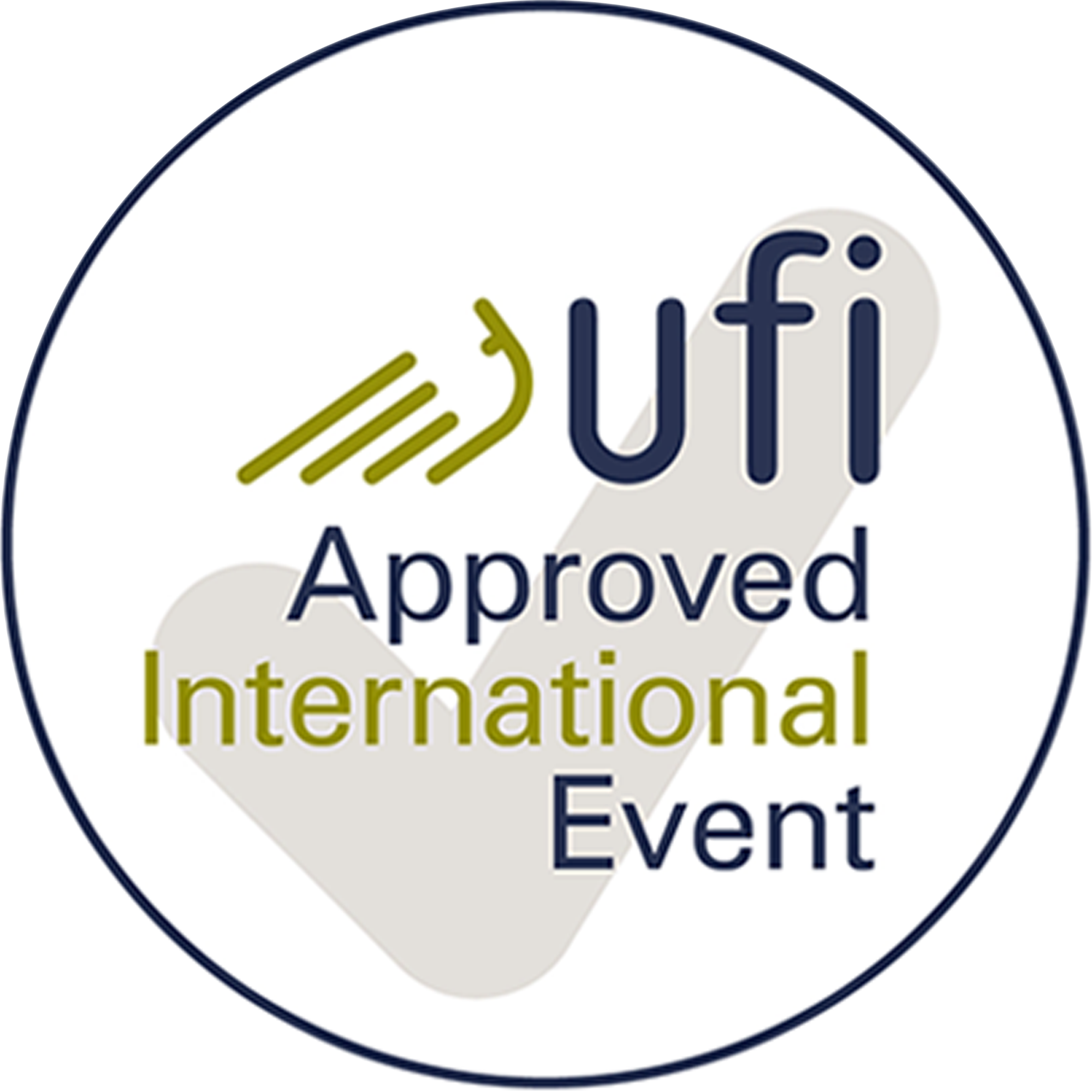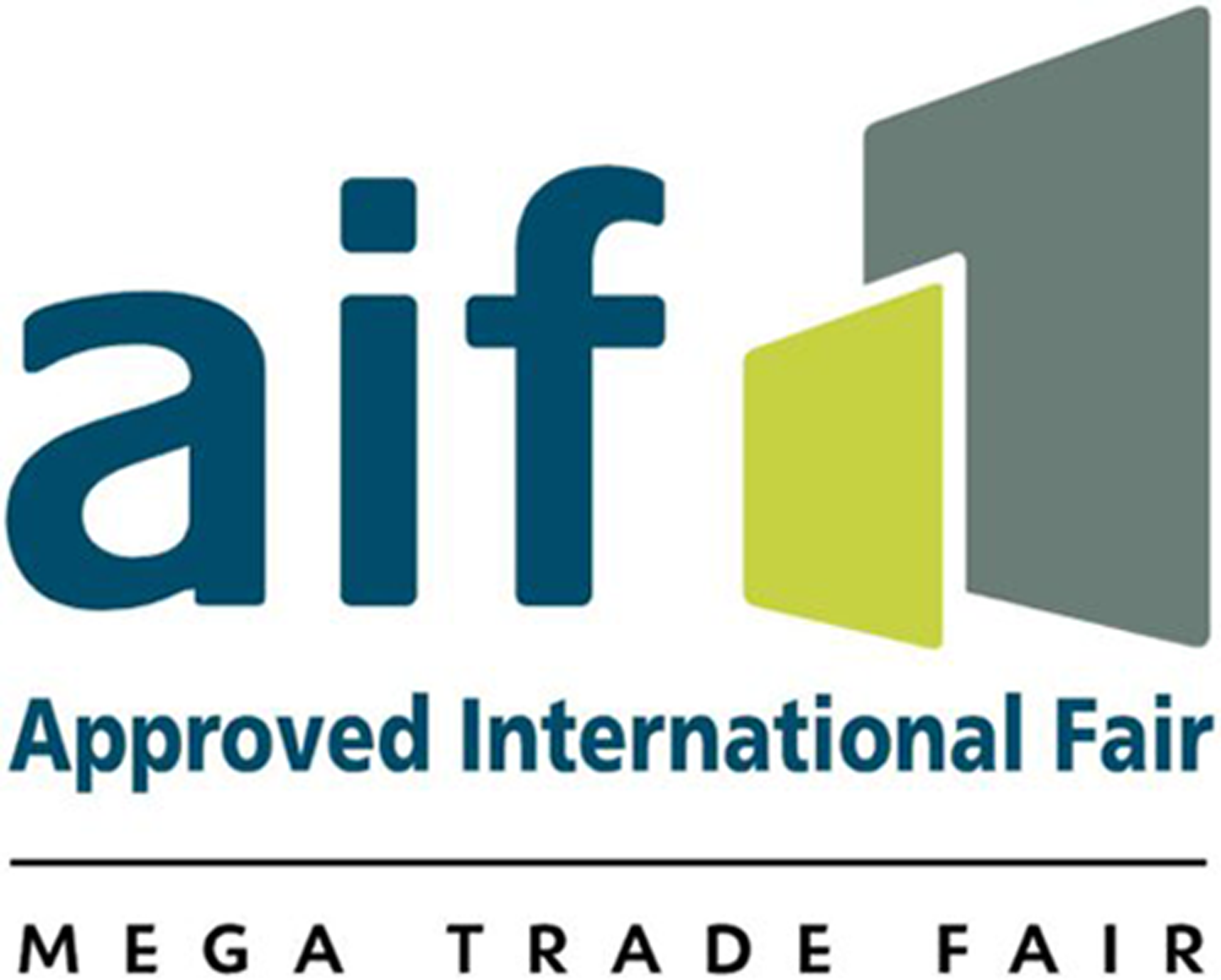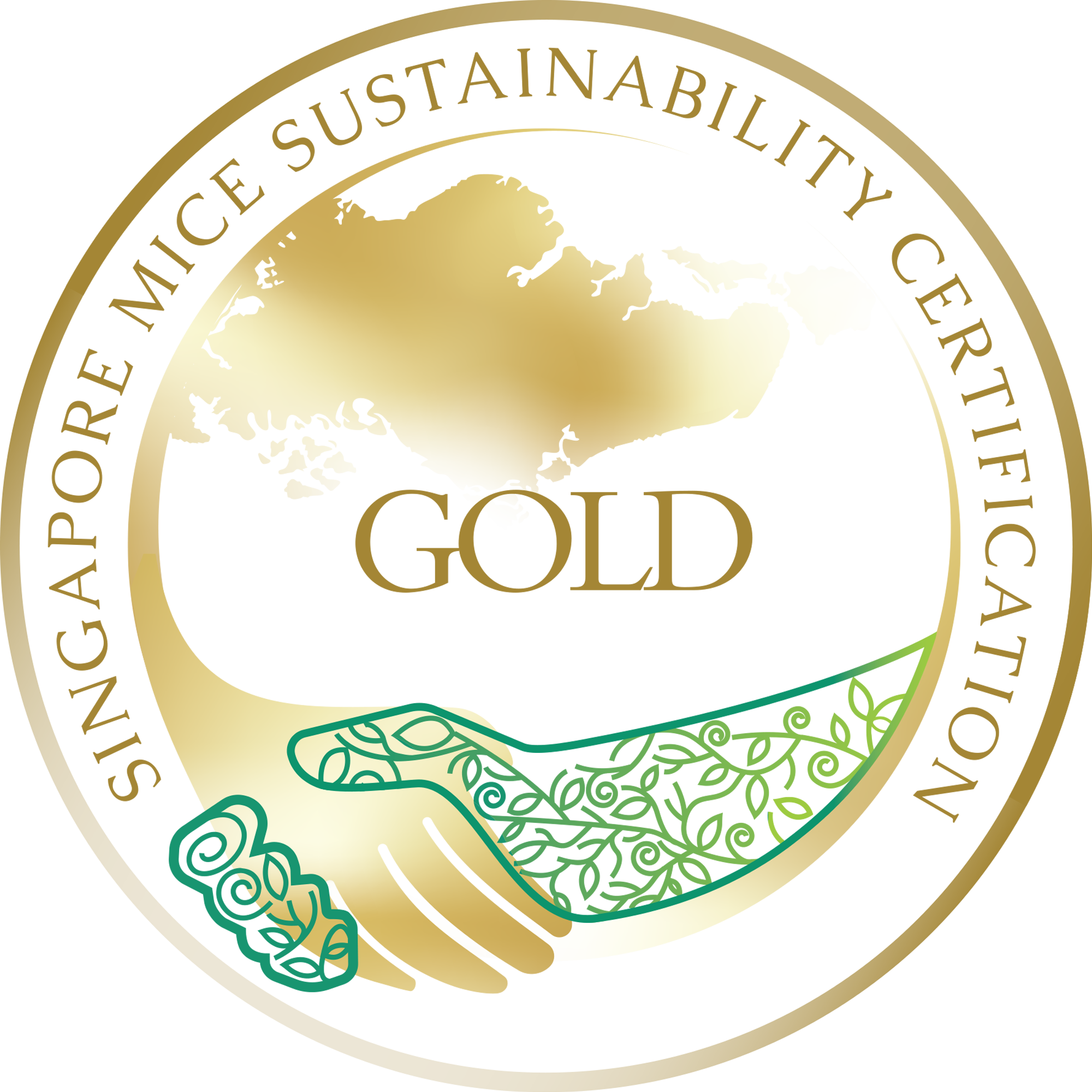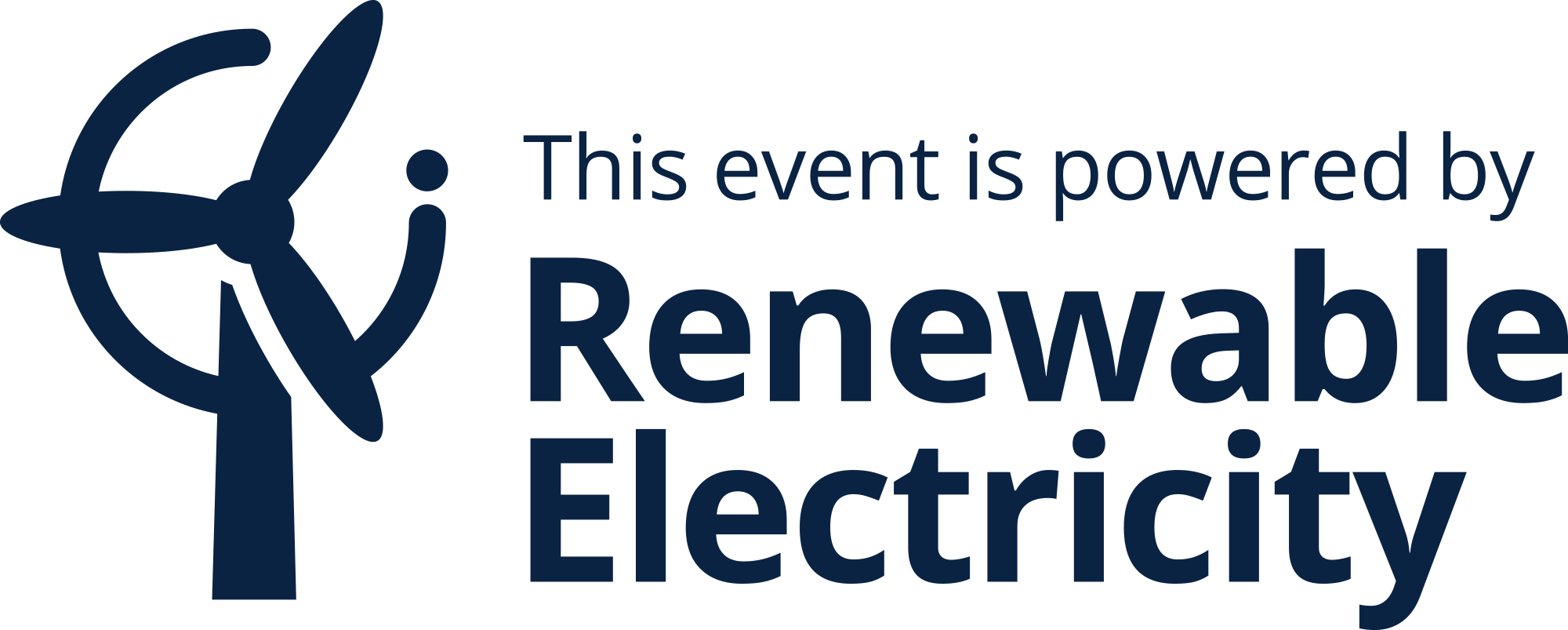Many of us enjoy eating seafood.
But did you know that around 60% of the seafood eaten worldwide is farmed?
Thus, it is one of our biggest opportunities to feed a growing population responsibly.
As overfishing threatens the world’s waters and marine life, aquaculture could be the answer to keeping fishermen working and ensuring we have enough food — all while doing so sustainably.
Therefore, it is necessary to understand what is aquaculture and find measures that are compatible with profitability as well as sustainability.
To achieve this, the current global trend is developing strategies to reduce aquaculture’s impacts to conserve natural capital, thus making it an environmentally friendly, efficient, profitable, and socially beneficial activity.
In this post, we will explore everything you need to know about aquaculture, its benefits, techniques, and systems, as well as sustainable seafood production.
What is Aquaculture?
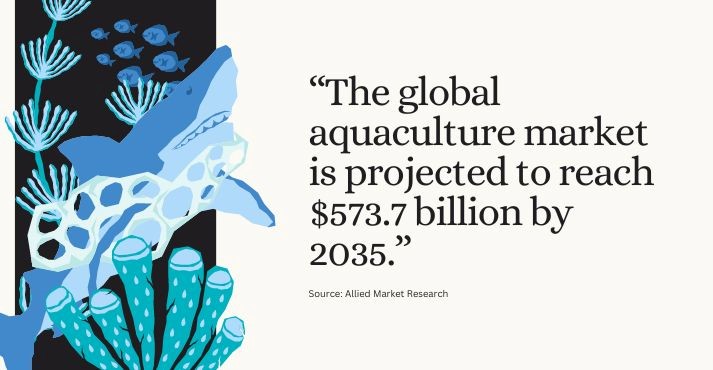
Aquaculture has existed for over 4,000 years, starting in China and spreading worldwide.
Aquaculture, known as aquafarming, is the breeding, raising, and harvesting of aquatic organisms like fish, shellfish, and seaweed in controlled environments. This method allows for the production of food and other resources while helping conserve natural ecosystems.
We need aquaculture for many reasons:
- producing food for humans to eat
- helping to rebuild populations of threatened and endangered species
- restoring habitats
- boosting wild stocks of freshwater and seawater species
- breeding fish for zoos and aquariums
The global aquaculture market is projected to reach $573.7 billion by 2035, growing at a CAGR of 5.2%. It’s the fastest-growing way to produce food and will be essential in feeding our planet as the population grows.
The current challenge in aquaculture is to increase production while balancing sustainability, animal welfare, and environmental issues.
Types of Aquaculture
Aquaculture involves different methods of farming aquatic organisms, depending on the environment and species involved.
Here are the main types:
Marine Aquaculture (Mariculture)
Marine aquaculture, or mariculture, refers to farming species in ocean or coastal environments.
This type of aquaculture is commonly used to produce high-value species like salmon, tuna, and shellfish. These species are typically raised in cages or pens in the open ocean or coastal waters, where they can access natural seawater.
Marine aquaculture is expected to more than double by 2050. As the seafood industry grows with rising living standards and population, production (excluding seaweed) is forecast to increase from 30 million to 74 million tonnes per year.
However, it must be carefully managed to avoid environmental issues like water pollution and the spread of diseases among farmed and wild fish.
Freshwater Aquaculture
Freshwater aquaculture is farming aquatic species in inland waters like rivers, lakes, and ponds. It is commonly used for species such as tilapia, catfish, and carp, which thrive in freshwater environments.
Freshwater aquaculture is particularly important in regions with limited ocean access. It provides a reliable source of protein and income for many communities.
According to data published on Forbes, the harvest from freshwater systems could be more than 60% higher than what is officially reported, or approximately 19% of global capture fisheries.
The methods used in freshwater aquaculture range from small-scale, traditional practices to large, commercial operations. Proper management is essential to ensure water quality and prevent the overuse of resources like water and feed.
Integrated Multi-Trophic Aquaculture (IMTA)
Integrated Multi-Trophic Aquaculture (IMTA) is an innovative and sustainable approach that involves farming multiple species together to mimic natural ecosystems.
In IMTA, species from different levels of the food chain are cultivated in the same system. For example, fish might be farmed alongside shellfish and seaweed.
The waste produced by the fish serves as nutrients for the shellfish and seaweed, creating a balanced and self-sustaining ecosystem. This approach not only reduces environmental impact but also increases productivity by making efficient use of resources.
IMTA is gaining attention as a way to make aquaculture more sustainable and environmentally friendly.
Urban Aquaculture
Urban aquaculture is the practice of farming fish and other aquatic species within city environments. Innovative solutions like indoor fish farms emerge as c growities and space becomes limited.
For example, in Singapore, urban aquaculture is becoming more common in producing fresh seafood near where people live. These systems often involve recirculating aquaculture systems (RAS), which recycle water and minimize waste.
Urban aquaculture reduces the need for seafood transportation and provides fresh, locally-produced food to urban populations.
Aquaculture Techniques and Systems
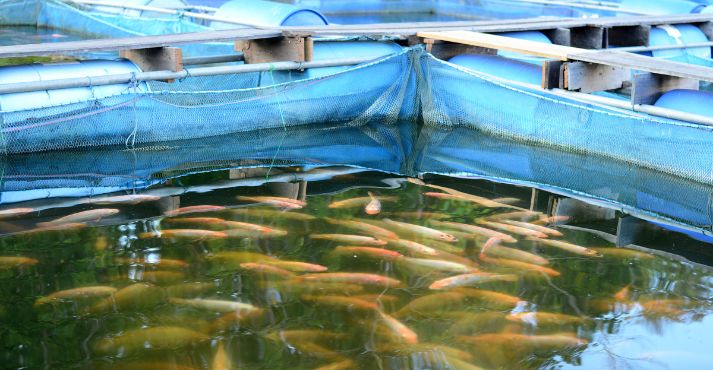
Aquaculture uses various techniques and systems to farm aquatic organisms, each offering unique benefits and challenges.
Open Systems
Open aquaculture systems involve farming organisms in natural bodies of water, such as oceans, lakes, or rivers. Examples include sea cages and pens, where fish like salmon or tuna are raised.
These systems allow the farmed species to grow in their natural environment, benefiting from the surrounding water conditions.
However, because these systems are open to the surrounding environment, they can pose risks, such as the spread of diseases to wild populations or pollution from waste.
Despite these challenges, open systems are widely used because they are cost-effective and can produce large quantities of seafood.
Closed Systems
Closed aquaculture systems, such as Recirculating Aquaculture Systems (RAS), are designed to provide greater control over the farming environment.
A closed system allows for precise control of water quality, temperature, and other factors affecting the farmed species’ health and growth. Also, these systems are typically used for high-value species like shrimp or tilapia and can be located in various settings, including urban areas.
The main advantages of closed systems are their ability to operate independently of natural water bodies and their reduced environmental impact. However, due to the technology required, they can be expensive to set up and maintain.
Aquaponics
Aquaponics is a unique system that combines aquaculture with hydroponics, the practice of growing plants in water without soil.
The fish and plants are grown together in a symbiotic environment in aquaponics. The waste produced by the fish provides nutrients for the plants, while the plants help filter and clean the water, which is then recirculated back to the fish tanks.
Aquaponic is a closed-loop system that is highly sustainable and efficient, as it maximizes the use of resources and minimizes food waste.
It is increasingly popular for small-scale farming, especially in urban areas, as it can produce fresh vegetables and fish in a relatively small space.
Offshore Aquaculture
Offshore aquaculture involves farming aquatic organisms in deeper, open ocean areas away from the coast. This approach reduces the environmental impact often associated with nearshore farming.
Offshore farms are typically located in areas with strong currents and deeper waters, which help disperse waste and reduce disease risk. These conditions also allow for farming species that require more space and better water quality, such as certain types of fish and shellfish.
While offshore aquaculture can be more challenging and costly due to the need for specialized equipment and infrastructure, it is seen as a promising solution for sustainably meeting the growing demand for seafood.
Benefits of Aquaculture
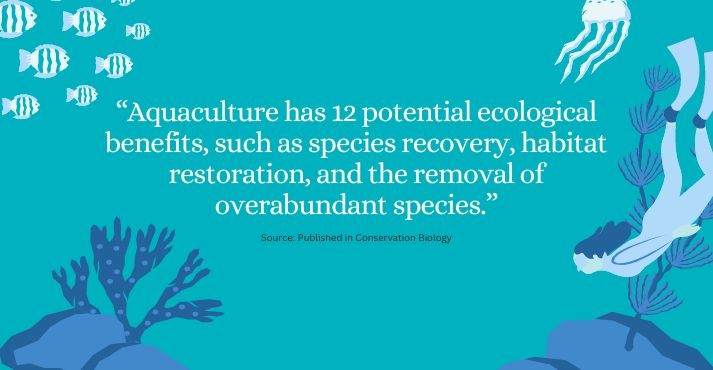
According to a new research conducted by the University of Melbourne, researchers have identified 12 potential ecological benefits of aquaculture, such as species recovery, habitat restoration, and the removal of overabundant species.
The research highlighted that while aquaculture’s negative impacts are well-known, its potential environmental benefits have been overlooked. Aquaculture can be a valuable tool for restoring degraded ecosystems and reversing biodiversity loss caused by human activities.
Here are some of the key benefits of aquaculture:
Sustainable Seafood Production
One of the most significant benefits of aquaculture is its role in promoting sustainable seafood production. Overfishing has put immense pressure on wild fish populations, threatening the balance of marine ecosystems.
Aquaculture provides an alternative by allowing us to produce seafood in controlled environments, reducing the need to harvest wild fish. This not only helps in conserving fish populations but also ensures that seafood remains available for future generations.
Moreover, sustainable aquaculture practices, such as Integrated Multi-Trophic Aquaculture (IMTA), further enhance sustainability by mimicking natural ecosystems and reducing waste.
Economic Impact
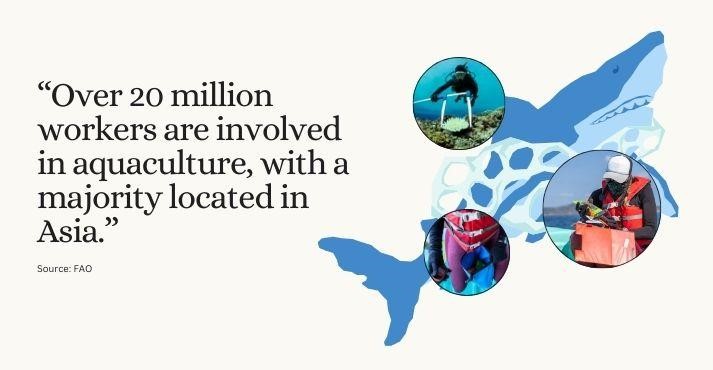
Aquaculture is a powerful driver of economic growth, particularly in regions where traditional fishing and agriculture may be limited. It creates jobs across various sectors, from farming and processing to marketing and distribution.
According to FAO, more than 20 million full-time and part-time workers were engaged in aquaculture, concentrated primarily in Asia (93.5 percent), followed by Africa (3.1 percent) and Latin America and the Caribbean (nearly 3 percent), and others.
The industry also generates significant export opportunities, allowing countries to trade seafood globally and boosting their economies. For many coastal and rural communities, aquaculture offers a sustainable livelihood, helping to reduce poverty and improve living standards.
As the industry continues to grow, it is likely to contribute even more to the global economy, particularly in regions where it is a key source of income.
Food Security
According to the FAO 2024 The State of World Fisheries and Aquaculture report, aquaculture production of aquatic animals for the first time surpassed capture fisheries, reaching 94.4 million tonnes. This accounted for 51 percent of global production and 57 percent of human consumption.
As the global population continues to grow, the demand for food, particularly protein, is increasing.
Aquaculture offers a solution by producing large quantities of seafood, a vital part of many diets worldwide. Fish and other aquatic organisms are rich in omega-3 fatty acids, vitamins, and minerals essential for human health.
By diversifying the food supply and reducing dependence on wild-caught fish, aquaculture contributes to a more stable and secure food system capable of feeding billions of people.
Innovation and Technology
The aquaculture industry is rapidly evolving, driven by continuous innovation in food technology. These innovations are improving aquaculture practices’ efficiency, sustainability, and productivity.
For example, advancements in foodtech have led to the development of more efficient and sustainable feeds, reducing the reliance on wild fishmeal and improving the growth rates of farmed species.
Disease management has also seen significant improvements, with new vaccines, treatments, and monitoring systems helping to reduce the spread of diseases and improve the overall health of farmed populations.
Environmental monitoring technology allows farmers to track water quality, temperature, and other critical factors in real time, ensuring optimal conditions for farm organisms.
Using technology in aquaculture is also paving the way for more sustainable practices. For example, recirculating aquaculture systems (RAS) use advanced filtration systems to recycle water, significantly reducing water usage and waste.
Additionally, offshore aquaculture, enabled by advancements in equipment and infrastructure, allows for farming in deeper waters with minimal environmental impact.
As technology advances, it will likely open new possibilities for aquaculture, further enhancing its benefits for both people and the planet.
Aquaculture and Sustainability
Aquaculture has the potential to contribute to global food security, but it must be practiced sustainably to minimize its environmental footprint.
Here’s a look at the sustainability aspects of aquaculture:
Environmental Impacts
While aquaculture provides a valuable source of seafood, it can also have negative environmental impacts if not managed properly.
One of the primary concerns is pollution, particularly from waste and excess feed, which can contaminate surrounding waters and harm local ecosystems.
Habitat destruction is another issue, as some aquaculture operations involve clearing mangroves, wetlands, or other sensitive areas to make way for fish farms.
Additionally, the close quarters in which fish are often kept can lead to disease outbreaks, spreading to wild populations and disrupting marine biodiversity.
Sustainable Practices
To address the environmental concerns associated with aquaculture, various sustainable practices have been developed.
Recirculating Aquaculture Systems (RAS) are one such method. Water is filtered and reused in these systems, reducing waste and minimizing the impact on natural water bodies.
Another sustainable approach is organic aquaculture, which avoids synthetic chemicals, antibiotics, and genetically modified organisms (GMOs) and focuses instead on natural growth processes and environmental stewardship.
Integrated Multi-Trophic Aquaculture (IMTA) is another innovative practice where different species are farmed together to mimic natural ecosystems, reducing waste and improving resource efficiency.
Most importantly, agritech innovations are transforming aquaculture, making it more sustainable by improving feed efficiency, reducing waste, and enhancing environmental monitoring.
Certification Schemes
Organizations like the Aquaculture Stewardship Council (ASC) certify farms that meet strict environmental and social standards.
These certifications ensure that the seafood produced is environmentally sustainable, socially responsible, and traceable from farm to table.
Consumers can look for ASC-certified products to support sustainable aquaculture practices.
Other certification programs, such as GlobalGAP and Best Aquaculture Practices (BAP), also help drive industry-wide improvements for environmental performance, animal welfare, and worker rights.
Conclusion
Aquaculture now supplies more than half of the fish we eat globally.
It offers a solution by providing a stable seafood supply without putting additional strain on overfished wild populations. However, as with any industry, it comes with its own set of challenges and responsibilities.
But still, environmentalists and farmers hope these innovations will help feed our growing population and protect our oceans.
As producers understand what is aquaculture and adopt these innovations, the industry’s sustainability and economic viability is improving through efficient feed and disease management and environmental monitoring.
As the aquaculture industry rapidly expands, new methods and ideas are being tested.
The industry’s growth and success will depend on the collective efforts of researchers, policymakers, farmers, and consumers to ensure that aquaculture contributes to global food security, environmental conservation, and economic development.







